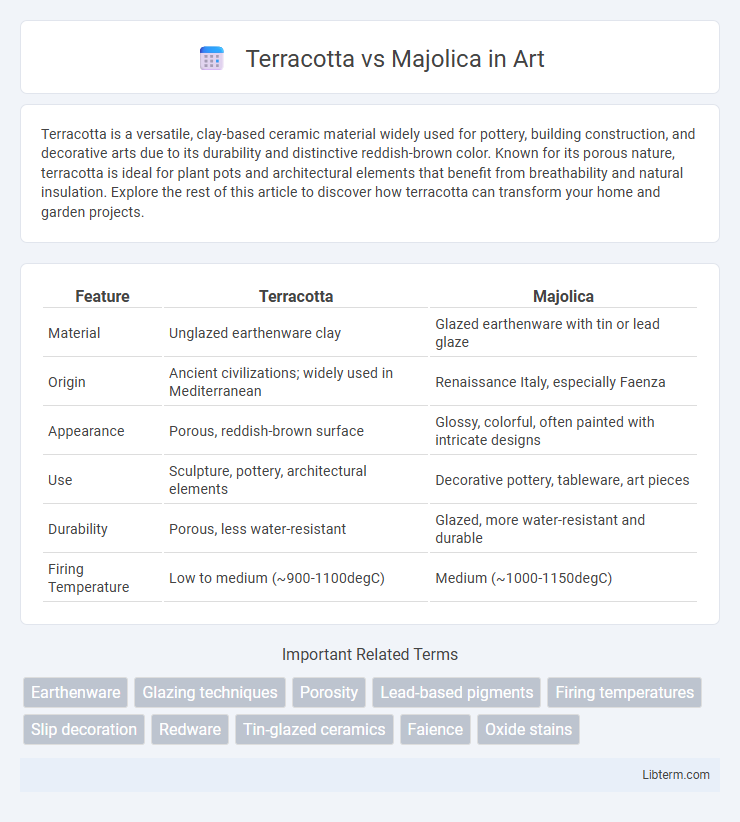Terracotta is a versatile, clay-based ceramic material widely used for pottery, building construction, and decorative arts due to its durability and distinctive reddish-brown color. Known for its porous nature, terracotta is ideal for plant pots and architectural elements that benefit from breathability and natural insulation. Explore the rest of this article to discover how terracotta can transform your home and garden projects.
Table of Comparison
| Feature | Terracotta | Majolica |
|---|---|---|
| Material | Unglazed earthenware clay | Glazed earthenware with tin or lead glaze |
| Origin | Ancient civilizations; widely used in Mediterranean | Renaissance Italy, especially Faenza |
| Appearance | Porous, reddish-brown surface | Glossy, colorful, often painted with intricate designs |
| Use | Sculpture, pottery, architectural elements | Decorative pottery, tableware, art pieces |
| Durability | Porous, less water-resistant | Glazed, more water-resistant and durable |
| Firing Temperature | Low to medium (~900-1100degC) | Medium (~1000-1150degC) |
Introduction to Terracotta and Majolica
Terracotta is a porous, unglazed ceramic made from natural clay, valued for its durability and breathability in pottery and architectural applications. Majolica, on the other hand, refers to tin-glazed pottery known for its bright, colorful surface decoration achieved through a white opaque glaze that provides a canvas for intricate painted designs. Both materials have distinct historical roots and manufacturing techniques, with terracotta being more utilitarian while majolica emphasizes ornamental artistry.
Historical Origins and Development
Terracotta originated in ancient civilizations such as Mesopotamia and the Indus Valley around 3000 BCE, known for its porous, reddish-brown clay used in sculptures and pottery. Majolica developed during the Italian Renaissance in the 15th century, characterized by tin-glazed earthenware with vibrant, detailed painted designs influenced by Islamic pottery techniques. The evolution of terracotta emphasizes utilitarian and architectural uses, while majolica highlights artistic expression and decorative functionality.
Key Material Differences
Terracotta is an unglazed, porous clay fired at low temperatures, making it ideal for pottery and sculptures that require breathability but less water resistance. Majolica, on the other hand, is a type of earthenware coated with a tin-based white glaze and fired at higher temperatures, resulting in a smooth, non-porous, and brightly decorated surface. The key distinction lies in terracotta's natural, porous red-brown material versus majolica's glazed, colorful finish that enhances durability and aesthetic appeal.
Artistic Styles and Techniques
Terracotta pottery showcases earthy, rustic textures achieved through unfired clay that is often hand-molded or coiled, reflecting ancient artisanal traditions and natural aesthetics. Majolica ceramics are characterized by their vibrant, tin-glazed surfaces, featuring intricate painted designs with bold colors and glossy finishes, stemming from Renaissance-era Italian techniques. The contrast between terracotta's matte, organic appeal and Majolica's bright, smooth enamel creates distinctly different visual and tactile artistic experiences.
Color Palettes and Decorative Motifs
Terracotta ceramics typically feature earthy, warm color palettes with natural reds, browns, and oranges derived from iron-rich clay, emphasizing rustic and organic decorative motifs inspired by flora, geometric patterns, and traditional designs. Majolica pottery showcases vibrant, contrasting color palettes including bright blues, greens, yellows, and whites achieved through tin-glazing techniques, often adorned with intricate floral, animal, and narrative motifs reflecting Renaissance and Mediterranean influences. The distinct color vibrancy and detailed ornamentation in Majolica contrast with the subdued, natural tones and simpler motifs characteristic of Terracotta ceramics.
Durability and Functional Uses
Terracotta is known for its porous nature, making it less durable and more susceptible to cracking or chipping when exposed to extreme weather or moisture compared to majolica. Majolica, a glazed ceramic, offers superior water resistance and durability, making it ideal for decorative pottery, tableware, and garden ornaments requiring both aesthetic appeal and longevity. While terracotta is commonly used for plant pots and rustic architectural elements, majolica's functional uses extend to tiles, dinnerware, and ornamental pieces that benefit from its glossy, protective finish.
Popular Regions and Cultural Significance
Terracotta pottery is prominently associated with Mediterranean regions such as Italy, Spain, and Greece, where its porous, reddish clay is used for both utilitarian and decorative purposes reflecting ancient cultural traditions. Majolica, known for its vibrant tin-glazed ceramic ware, has strong roots in Italy and later became popular in Spain and Mexico, symbolizing the fusion of Moorish, European, and indigenous artistic influences. Both materials hold significant cultural value, representing regional craftsmanship and historical continuity in pottery, with terracotta emphasizing rustic durability and majolica highlighting colorful, intricate designs.
Modern Applications and Trends
Terracotta and majolica ceramics have seen renewed interest in contemporary architecture and interior design, with terracotta prized for its durability and natural, earthy aesthetic in sustainable building facades and garden planters. Majolica, known for its vibrant, glazed surfaces and intricate patterns, is increasingly used in decorative wall tiles and artisanal kitchen backsplashes, blending traditional craftsmanship with modern color trends. Both materials benefit from advancements in production technology that enhance their weather resistance and customization, aligning with the demand for eco-friendly and visually striking design elements.
Maintenance and Care Tips
Terracotta requires sealing to prevent water absorption, and regular cleaning with mild soap and water maintains its durability; avoid using harsh chemicals to prevent surface degradation. Majolica, characterized by its glazed finish, is more resistant to stains and easier to clean but should be handled carefully to avoid chipping the delicate glaze. Both materials benefit from avoiding prolonged exposure to freezing temperatures to prevent cracking and ensuring proper drying to inhibit mold or mildew growth.
Choosing Between Terracotta and Majolica
When choosing between terracotta and majolica, consider the intended use and aesthetic preferences, as terracotta offers natural, porous qualities ideal for outdoor planters and rustic decor while majolica provides a vibrant, glazed finish suited for decorative tiles and fine pottery. Terracotta's breathable composition enhances plant health, but requires sealing for indoor use, whereas majolica's impermeable glaze ensures water resistance and intricate color patterns. Durability and maintenance differ significantly; terracotta may chip or crack under freeze-thaw cycles, whereas majolica demands careful handling to avoid glaze damage.
Terracotta Infographic

 libterm.com
libterm.com